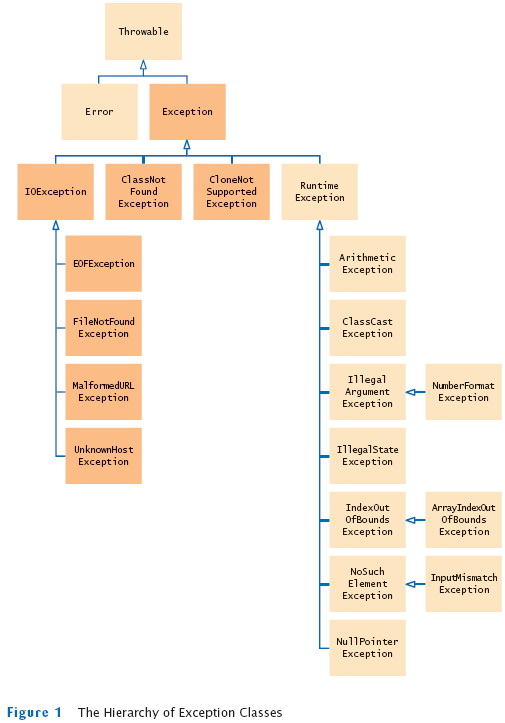本文主要是介绍黑马程序员——异常处理全过程:不怕一万,就怕万一,希望对大家解决编程问题提供一定的参考价值,需要的开发者们随着小编来一起学习吧!
------<ahref="http://www.itheima.com" target="blank">Java培训、Android培训、iOS培训、.Net培训</a>、期待与您交流! -------
异常的基本概念
异常的分类

Error类:严重的问题,一般不编写针对性的代码对其进行处理。Exception类:非严重的问题,可以使用针对性的处理方式进行处理。
Exception还可以进一步分成两类:
非RuntimeException:
1,编译时被检测的异常。
2,该异常在编译时,如果没有处理(没有抛也没有try),编译失败。
3,该异常被标识,代表这可以被处理。
RuntimeException:
1,编译时不被检测的异常,RuntimeException及其子类都是运行时的异常
2,在编译时,不需要处理,编译器不检查。
3,该异常的发生,建议不处理,让程序停止。需要对代码进行修正。
异常处理的基本格式
try {//需要被检测的代码:statements that can throw exceptions} catch (Exception e) {//处理异常的代码:statements executed when exception is thrown}finally {//一定会执行的代码:statements are executed whether or not exceptions occour}一个会产生异常的代码示例
class Division
{int div(int a,int b){return a/b;}
}class ExceptionDemo
{public static void main(String[] args) {Division d = new Division();int x = d.div(4,1);/** x=4 * over*/int y = d.div(4, 0);//在编译时期不会报错/* Exception in thread "main" java.lang.ArithmeticException: / by zeroat Division.div(ExceptionDemo.java:5)at ExceptionDemo.main(ExceptionDemo.java:19)该异常发生后,其下语句一概未执行*/System.out.println("x=" + x);System.out.println("y=" + y);System.out.println("over");}
}异常的处理过程
try...catch:尝试、捕获与处理
class Division
{int div(int a,int b){return a/b;}
}class ExceptionDemo
{public static void main(String[] args) {Division d = new Division();try{int x = d.div(4,0);//异常发生之处System.out.println("x="+x);//此处的代码不再执行}catch (Exception e)//Exception e = new ArithmeticException();相当于多态{System.out.println("除零啦");/*除零啦over*/System.out.println(e.getMessage());//String getMessage():获取异常信息。
/*/ by zeroover*/System.out.println(e.toString());// 异常名称 : 异常信息。/*java.lang.ArithmeticException: / by zeroover*/e.printStackTrace();//异常名称,异常信息,异常出现的位置。打印异常的堆栈的跟踪信息。/*java.lang.ArithmeticException: / by zeroat Division.div(ExceptionDemo.java:5)at ExceptionDemo.main(ExceptionDemo.java:17)over*///其实jvm默认的异常处理机制,就是在调用printStackTrace方法。} System.out.println("over");//因为有了catch语句,此处的over总是会执行到}
}在方法上throws一个Exception:
class Division
{int div(int a,int b) throws Exception//在功能上通过throws的关键字声明了该功能有可能会出现问题。{return a/b;}
}class ExceptionDemo
{public static void main(String[] args) {Division d = new Division();int x = d.div(4,0);//异常发生之处//此时不处理这个问题,编译就不会通过,把问题转换到编译时期/*Exception in thread "main" java.lang.Error: Unresolved compilation problem: Unhandled exception type Exceptionat ExceptionDemo.main(ExceptionDemo.java:16)*/System.out.println("over");}
}throws:我也不管了,抛出去让上面处理
class Division
{int div(int a,int b) throws Exception//在功能上通过throws的关键字声明了该功能有可能会出现问题。{return a/b;}
}class ExceptionDemo
{public static void main(String[] args) throws Exception{Division d = new Division();int x = d.div(4,0);//异常发生之处//此时不处理这个问题,编译就不会通过,把问题转换到编译时期/*Exception in thread "main" java.lang.ArithmeticException: / by zeroat Division.div(ExceptionDemo.java:5)at ExceptionDemo.main(ExceptionDemo.java:16)*/System.out.println("over");//在抛的情况下,最后的这行代码不会执行到}
}多异常处理
2,对方声明几个异常,就对应有几个catch块。不要定义多余的catch块。
3,如果多个catch块中的异常出现继承关系,父类异常catch块放在最下面。
4,建立在进行catch处理时,catch中一定要定义具体处理方式。不要简单定义一句 e.printStackTrace(),也不要简单的就书写一条输出语句。
class Demo2
{int div(int a,int b) throws ArithmeticException,ArrayIndexOutOfBoundsException//在功能上通过throws的关键字声明了该功能有可能会出现问题。{int[] arr = new int[a];System.out.println(arr[4]);return a/b;}
}class ExceptionDemo2
{public static void main(String[] args) //throws Exception{Demo2 d = new Demo2();try{int x = d.div(4,1);//脚标越界异常int y = d.div(3, 0);//除零异常System.out.println("x="+x);}catch (ArithmeticException e){System.out.println(e.toString());System.out.println("被零除了!!");}catch (ArrayIndexOutOfBoundsException e)//越界异常和除零异常不会同时执行到,一旦越界后面就不会执行{System.out.println(e.toString());System.out.println("角标越界啦!!");}catch(Exception e)//父类异常一定要放在最下面,否则会报错,而且不建议这样写,会把问题给隐藏起来,真发生其他问题,就让程序停掉{System.out.println("hahah:"+e.toString());}/*如果把catch(Exception e)放到catch块最上面*在它下面再catch ArithmeticException和ArrayIndexOutOfBoundsException,会发生如下错误:Exception in thread "main" java.lang.Error: Unresolved compilation problems: Unreachable catch block for ArithmeticException. It is already handled by the catch block for ExceptionUnreachable catch block for ArrayIndexOutOfBoundsException. It is already handled by the catch block for Exceptionat ExceptionDemo2.main(ExceptionDemo2.java:31)*/System.out.println("over");}
}
自定义异常
因为项目中会出现特有的问题,而这些问题并未被java所描述并封装对象。所以对于这些特有的问题可以按照java的对问题封装的思想。将特有的问题。进行自定义的异常封装。
异常体系有一个特点:因为异常类和异常对象都被抛出。他们都具备可抛性。这个可抛性是Throwable这个体系中独有特点。只有这个体系中的类和对象才可以被throws和throw操作。
throws:使用在函数上,后面跟的异常类可以跟多个,用逗号隔开。throw:使用在函数内,throw后跟的是其抛出的异常对象。
/*
需求:在本程序中,对于除数是-1,也视为是错误的是无法进行运算的。
那么就需要对这个问题进行自定义的描述。*/
class Demo3
{int div(int a,int b)throws FuShuException//此处选择第二种处理方式,在函数上声明让调用者处理/*当在函数内部出现了throw抛出异常对象,那么就必须要给对应的处理动作。要么在内部try catch处理。要么在函数上声明让调用者处理。*/{if(b<0)//在函数内部出现了throw抛出异常对象throw new FuShuException("出现了除数是负数的情况------ / by Negative",b);//手动通过throw关键字抛出一个自定义异常的对象。return a/b;}
}class FuShuException extends Exception //getMessage();
{/*如何定义异常信息?因为父类中已经把异常信息的操作都完成了。所以子类只要在构造时,将异常信息传递给父类通过super语句。那么就可以直接通过getMessage方法获取自定义的异常信息。*/private int value;/*对比:麻烦的方式-复写getMessage方法private String msg;FuShuException(String msg){//构造函数overload,获取传入的初始化msgthis.msg = msg}public String getMessage()//复写getMessage()的方法{return msg;}*/FuShuException()//Throwable中已经有getMessage()方法了,不必再复写了{super();}//为了能够获取到输入错误的值所超载的构造函数FuShuException(String msg,int value)//把分母的值传给了value{super(msg);//把msg传给父类Throwable的构造函数this.value = value;}public int getValue()//封装,提供外界获取其值的方法{return value;}}class ExceptionDemo3
{public static void main(String[] args) {Demo3 d = new Demo3();try{int x = d.div(4,-9);//int div(int a,int b)throws FuShuException,所以必须选择两种处理方式中的一种System.out.println("x="+x); }catch (FuShuException e){System.out.println(e.toString());/*FuShuException: 出现了除数是负数的情况------ / by Negativeover*/System.out.println("除数出现负数了");/*除数出现负数了over*/System.out.println("错误的负数是:"+e.getValue());/*错误的负数是:-9over*/System.out.println(e.getMessage());/*出现了除数是负数的情况------ / by Negativeover*/}System.out.println("over");}
}
RuntimeException:运行时异常
class Demo4
{//第一种情况:RuntimeException 运行时异常/*在函数内容中通过throw关键字抛出该异常*函数上可以不用抛出,编译一样通过**如果不是RuntimeException,在函数内容中抛出该异常*则要使用两种处理方式:*1.在函数声明时throws:int div(int a,int b) throws Exception**2.在函数声明的内部:try...catch:int div(int a,int b){if(b==0)try{throw new Exception("被零除啦");} catch (Exception e) {e.printStackTrace();}return a/b;}*/int div(int a,int b){if(b==0)throw new ArithmeticException("被零除啦");//函数内部抛出错误了//如果此处是throw new Exception();将会编译失败return a / b;}//第二种情况:在函数上声明了该异常。调用者可以不用进行处理。编译一样通过;/*如果不是RuntimeException,需要两种处理方式:* 1. 调用者throws:* public static void main(String[] args) throws Exception * 2. 调用者try..catchDemo4 d = new Demo4();int x = d.div(4,0);try {int y = d.div2(3, 0);} catch (Exception e){e.printStackTrace();}*/int div2(int a,int b) throws ArithmeticException{return a / b;}}class ExceptionDemo4
{public static void main(String[] args) //函数内部抛出错误了,在主函数调用时却没有try...catch,也没有throws,因为Arithmetic异常是运行时异常{Demo4 d = new Demo4();int x = d.div(4,0);int y = d.div2(3, 0);System.out.println("x=" + x); /*Exception in thread "main" java.lang.ArithmeticException: 被零除啦at Demo4.div(ExceptionDemo4.java:6)at ExceptionDemo4.main(ExceptionDemo4.java:17)*/System.out.println("y=" + y);//如果int x = d.div(4,0);已经发生异常,则此处不会被执行到/*Exception in thread "main" java.lang.ArithmeticException: / by zeroat Demo4.div2(ExceptionDemo4.java:53)at ExceptionDemo4.main(ExceptionDemo4.java:66)*/System.out.println("over");}
}
finally
try
{//连接数据库;//数据操作;;
}
catch (SQLException e)
{//对数据库进行异常处理;
}
finally
{//关闭数据库;//该动作,无论数据操作是否成功,一定要关闭资源。
}
public class CrazyWithZeros {public static void main(String[] args) {try{int answer = divideTheseNumbers(5, 0);}catch(Exception e)//5. 捕获到由divideTheseNumbers throws过来的Arithmetic异常,并给出相应的处理方法{System.out.println("Tried Twice, still didn't work");//6. 输出该异常处理的语句}}public static int divideTheseNumbers(int a, int b) throws Exception{int c = 0;try {c = a / b;System.out.println("It worked!");} catch (Exception e) //1.发生异常后最先进入该catch块内{System.out.println("Didn't work the first time.");//2.输出异常处理语句c = a / b;//3.再次运算a / b,再次发生异常,这一次发生异常,没有与之对应的catch块来处理该异常System.out.println("It worked the second time!");//因为前面出现异常,这行代码永远不会执行到}finally{System.out.println("Better clean up my mess.");//4.执行finally语句中的内容,不管如何,该行代码总会运行}//finally执行完之后,由于在catch块中发生了异常,又没有嵌套的catch块来进行处理,通过//public static int divideTheseNumbers(int a, int b) throws Exception,将系统自动捕获到的Arithmetic异常抛给上级调用者,此处是主函数System.out.println("It worked after all");return c;}
}
/*
Didn't work the first time.
Better clean up my mess.
Tried Twice, still didn't work*/
异常在子父类覆盖中的体现
2,如果父类方法抛出多个异常,那么子类在覆盖该方法时,只能抛出父类异常的子集。
3,如果父类或者接口的方法中没有异常抛出,那么子类在覆盖方法时,也不可以抛出异常。
4,如果子类方法发生了异常。就必须要进行try处理。绝对不能抛。
class AException extends Exception
{
}class BException extends AException
{
}class CException extends Exception
{
}/*
Exception |--AException|--BException|--CException
*/
class Die
{void show()throws AException{}
}class Er extends Die
{void show()throws BException//此处只能抛出A异常或者B异常,抛出C异常则出错,子类的覆盖方法,只能抛出父类的异常或者该异常的子类。{}
}
这篇关于黑马程序员——异常处理全过程:不怕一万,就怕万一的文章就介绍到这儿,希望我们推荐的文章对编程师们有所帮助!









